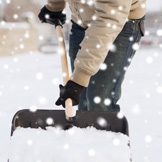
Published on December 12, 2016
“Shovel Ready” Backs for the Season
Winter brings new challenges for your body – especially your spine. Shoveling requires extra, repetitive movements that are hard on your spine. It’s time to prepare your body for these new seasonal demands.
Flexibility & Strength Make the Difference
“Work on flexibility and strength to help maintain a neutral spine during activity,” says Scott Krueger, Physical Therapist and Rehabilitation Services Manager at Midwest Orthopedic Specialty Hospital and Ascension SE Wisconsin Hospital – Franklin Campus. “A neutral spine is when your back and pelvis aren’t flexed too far or bent backward.”
If the muscles in your upper legs are tight, they’ll act like an anchor. Your pelvis and hips won’t be able to move into a neutral position. This places extra stress on the lower back.
“While both the front and back of legs are key for flexibility, your hamstrings are especially important for bending activities,” says Krueger. “While there are several ways to stretch your hamstrings, it’s ideal to do so when your spine is in a neutral position.”
To encourage flexibility and bending with a neutral spine, lay on the ground for back support during this exercise. Gently hold your leg behind the knee,
and extend your foot up into the air. Do this for both legs.
You’ll also need sufficient strength to hold your neutral position throughout your snow removal. “It’s especially important to strengthen your ‘core,’ which includes abdominal, back and hip muscles, and move in a neutral position,” says Krueger.
For this exercise, bring one knee up and then return. Do this for both legs. Keep your pelvis still – do not let it rock backward or forward.
To do these strengthening movements, tighten stomach and raise leg and opposite arm, making sure to work both sides. Keep trunk rigid.
“Finally, once you’ve mastered these exercises, you need to learn how to use your flexibility and strength while shoveling,” says Krueger. “It’s ideal to have your larger hip and knee joints take on the stress of bending.”
Bend from your hips to reach forward and engage your abdominal muscles to protect your back. If you feel yourself falling out of a neutral position or start to feel tired, stop and stretch your spine backwards. Then reengage your core muscles and check that you are bending at your knees and hips, and begin again.